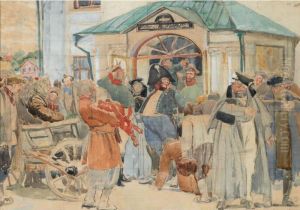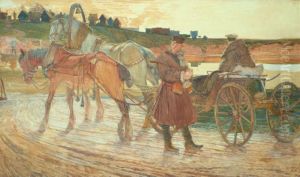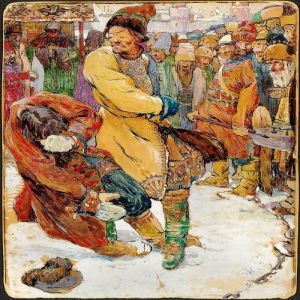Dimitri Kardovsky Paintings
Dimitri Nikolaevich Kardovsky was a prominent Russian artist and illustrator born on August 18, 1866, in the village of Kursk, Russia. He was particularly known for his role in reviving the Russian tradition of wood engraving and for his illustrative works. Kardovsky studied at the Moscow School of Painting, Sculpture, and Architecture before moving to the Imperial Academy of Arts in Saint Petersburg, where he was a student from 1887 to 1896. Under the tutelage of Pavel Chistyakov, Kardovsky honed his skills in drawing and painting, and his early work was influenced by the Peredvizhniki (Wanderers) movement, which aimed at promoting Russian realist art.
After completing his studies, Kardovsky traveled to Europe where he was exposed to the works of contemporary Western artists, which influenced the development of his own style. Upon his return to Russia, he became a professor at the Imperial Academy of Arts in 1907 and taught there until 1918, influencing a generation of Russian artists. Kardovsky was an active member of the art community and was involved with various art societies, including the 'World of Art' movement, which sought to integrate Russian art into the wider European context.
As an illustrator, Kardovsky is known for his work in books and magazines. His illustrations for Russian literary classics, such as the works of Anton Chekhov and Leo Tolstoy, are particularly noted for their keen psychological insight and attention to detail. He also worked as a stage designer and contributed to the design of several theaters in Russia.
During the early Soviet period, Kardovsky's realist approach fell out of favor with the rise of Socialist Realism, and he faced challenges in this new political and artistic landscape. Despite this, he continued to work and create art until his death on November 9, 1943, in Leningrad (now Saint Petersburg), during the siege of the city in World War II. Kardovsky's legacy is preserved in his contributions to Russian art, particularly in the field of illustration, and his works are held in several Russian museums, including the Tretyakov Gallery and the Russian Museum.


